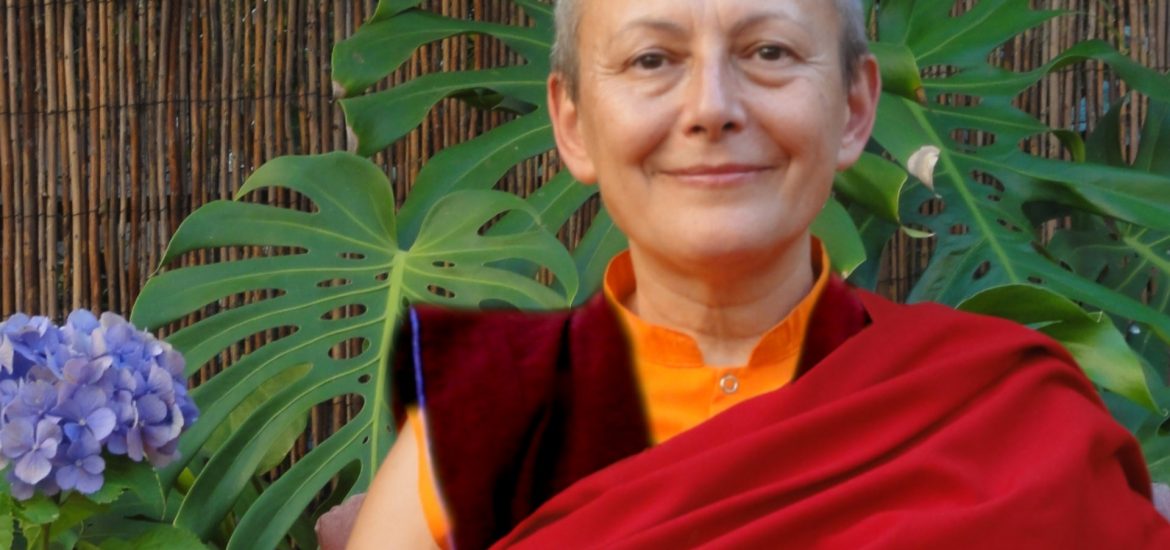Despite having been excluded from the upper echelons of religious leadership in many traditions, women play a core part in religious communities. Women tend to attend religious rituals more regularly than men, and bring their male relations and spouses to these events. In more traditional societies, women facilitate community cohesion and assist the integration of the local religious institution. In societies undergoing change, women can see an opportunity to join a religious institution and be their own person, or even lead.
In traditionally Catholic Brazil and Spain, the female Buddhist leader is very much a unique figure. It is perhaps not a surprise that some of the most important figures are bhikkhunis, women that have made the free choice to enter into the monastic life and disseminate the Dharma.
Two of these pioneering figures, a Zen priestess and a Vajrayana bhikkhuni, have been interviewed by one of our columnists, Fina Iñiguez Abad. Fina is a Hispanic-Brazilian who has worked as a publicist and journalist in São Paulo, Barcelona, and Madrid. She has collaborated with Spanish-language and international outlets like Rádio BBC News-Brasil, O Estado de São Paulo, and Rádio França Internacional-Brasil. Since 2006, she has been in charge of communications for the Casa del Tíbet Foundation in Barcelona and now works with not only BDE but also with the Catalan Coordinator of Entitats Budistes and Sakyadhita Spain.
In “Entrevista a Monja Coen: la maestra zen más popular de Brasil,” Fina speaks to Monja Coen, who Fina calls one of the leaders of Zen in Brazil. Monja Coen is considered a religious celebrity in the country, not only due to her charisma but also her relatability. She first married at the age of 14, and had a total of five marriages before ordaining at the age of 36 in 1983. During this time, she worked in both São Paulo and London, before learning about Zen in California. Now, she combines her dedication to the Dharma with her roles as mother, grandmother, and great-grandmother. At present, she has a devoted following both offline and online. She offers teachings on Instagram and YouTube from her former family home, which has now been converted into the Taikozan Tenzuizen-ji temple in São Paulo. She has also written dozens of books and has a Monday radio show, Zen Moment.

As a community leader, she has wise words to offer about the suffering wrought by the pandemic: “There are people who, through social isolation, have deepened their self-knowledge, have been able to live more simply, and take better care of themselves and others. There were also those who took advantage of the circumstances to abuse, steal, or cheat. Each person creates their own karma. Thus, we are all responsible for the reality in which we exist. And, upon awakening, we can transform that reality in ways that make it more loving, caring, wise, and tender. The journey of awakening through the practices of zazen is the path for social, political and economic transformation.”
We fly over to Spain’s Girona Province in “Entrevista a Lama Tsondru: trabajar para el dharma fue encontrar el sentido de mi vida,” where Fina interviewed Guelongma Lama Tsondru. She was born in the small Catalan town of Breda. Like Monja Coen, Lama Tsondru turned to Buddhism after a profound life experience, in Lama Tsondru’s case, this was her mother’s passing. Only 19 at the time, Lama Tsondru set out to discover some spiritual truths for her own enlightenment and comfort, before encountering Vajrayana Buddhism.
She tells Fina: “Ultimately, my journey took me to the Kagyu Samye Ling Tibetan monastery in Scotland, where I met my future teacher, Akong Rinpoche. The impact was enormous, I asked him to come to Spain since Buddhism did not exist in our country and I saw how useful, how important it could be for many people.” In 1977, she opened the first Buddhist center in Barcelona so that her teacher, Akong Rinpoche, could impart the teachings that had changed her life.
In Scotland, Lama Tsondru recounts that she was not discriminated based on her gender at Kagyu Samye Ling. “The proof is that this monastery over the years has only recognized three people as master lamas, and we are three nuns,” she tells Fina. “However, when I go to India to receive teachings from my teachers, in the Buddhist monasteries of monks, I do not count as a lama there. Even the young monks look down on me. Senior monks cannot believe that you teach the dharma and they laugh if you say you are a lama, because that is not possible, they say.”
This seems to indicate that gender discrimination, sexism, and patriarchy itself is not part of the DNA of Buddhism, but rather a cultural accretion that can be countered or eliminated. Lama Tsondru notes: “I have experienced a change over the years. His Holiness the Karmapa has been actively working to break this discrimination. Nuns are being allowed to have access to higher studies in Buddhist philosophy and to get the title of Geshemas, something previously unthinkable since the intelligence of women was considered inferior. There is still discrimination everywhere in the Buddhist field, and it is mainly due to the push and work of Western women that little by little the situation is changing.”
These are only two examples of female Buddhist leaders that have made a significant impact on Buddhism in Portuguese-speaking Brazil, and Buddhism in Catalan and Spain more widely. We will be discussing more of these leaders in future posts.


